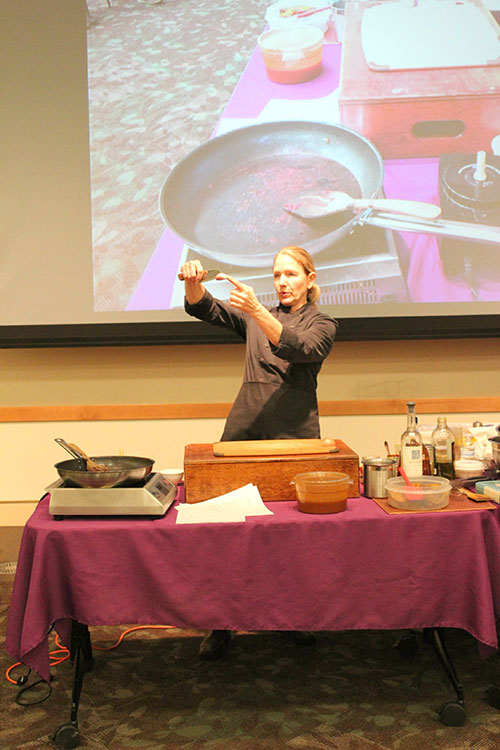During her March 6 French Sauces cooking demonstration held at Central Park Library, Chef Laura Stec offered a tip about caramelizing vegetables, deglazing the pan with water, stock or wine to lift the fond (the shed layer of vegetables on a pan) and then adding the flavor-packed fond to a sauce. Stec emphasized that not to be confused with deglazing is the demi-glace, a sauce ingredient made from beef stock.
“There are so many cultures out in the world with so many ideas of how food is structured and put together,” Stec said. “It just so happens that the French put it in a nice little package so we can create systems from that.”
Stec discussed the mother sauces of French cuisine that has given birth to other sauces. One such mother sauce is the espagnole, made with brown stock and brown roux (flour and fat together), and one of its offspring is Sauce Robert, made with shallot, Dijon mustard and cracked black peppercorn. After Stec demonstrated how to make the sauce, attendees sampled the sauce, which came with a hint of heat, over slices of beef.
Next, Stec made Beurre Blanc, a white sauce with lemon juice, white wine and heavy cream. This sauce gave the pieces of salmon that attendees sampled a creamier texture. Unlike the Sauce Robert, the Beurre Blanc doesn’t come from a mother sauce, unless one considers butter a mother sauce, Stec joked. Both recipes were adapted from the Culinary Institute of America. The class where these recipes were taught was inspired by the work of cookbook authors such as Julia Child and Jacques Pépin.
Citing Harold McGee, food science writer, Stec shared four ways to thicken a sauce: through particles, molecules, bubbles, or droplets. She explained that sauces are mostly flowing water and if things are in its way, such as starches, gelatin or particles of food, they would block the water from moving and therefore thicken the sauce.
“So for a particle, it is basically a piece of food that can get in the way of the water, such as a tomato sauce or a nut butter sauce,” Stec said. “When you thicken with a starch by adding heat and water, the starch molecules get bigger and impede the water flow.”
Stec also gave the example of thickening with bubbles by illustrating how air can be added to a liquid to create a cappuccino or the froth on top of a beer. Air added into milk can also bring water and fat together. Stec likened a droplet to vinaigrette, where oil and vinegar (fat and water) don’t mix. Here, one can add to the vinaigrette an emulsifier that attracts both water and fat, such as Dijon mustard. Stec compared an emulsifier to a lollipop-where the candy is drawn to the oil and the stem is drawn to the vinegar- and it brings both elements together.
Stec’s demonstration is the library’s first in a series of cooking demonstrations that will bring attendees’ taste buds to different counties around the world.
“We just want to introduce different styles of cooking to our public,” said librarian Jenny Hsiao.
On March 13, Stec gave a demonstration on preparing Vietnamese sauces. On March 20 at 11 a.m., Stec will give a presentation on Macrobiotic Sauces also at the Central Park Library.
